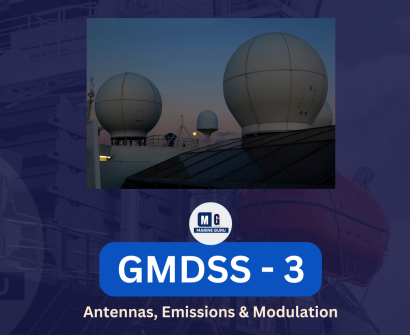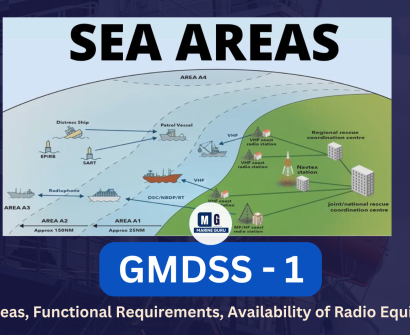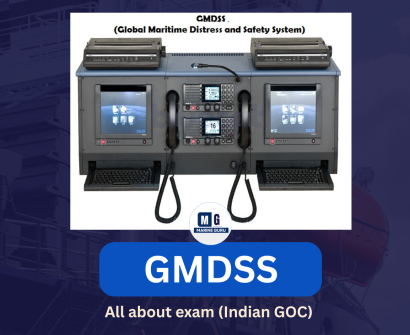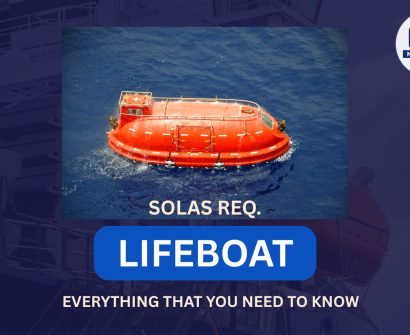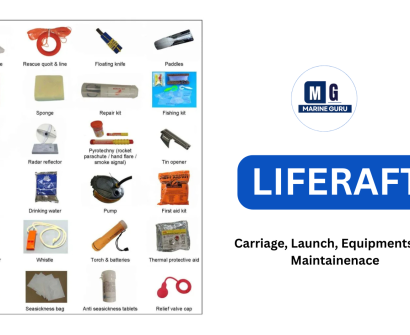
Every seafarer must understand how radio communication actually works — not just to pass exams, but to operate safely when emergencies strike.
In this MarineGuru master guide, you’ll learn:
✅ How each GMDSS radio equipment (VHF, MF, HF) functions
✅ What their modes of operation (DSC, Radiotelephony, NBDP) mean in real life
✅ The four propagation types (Ground, Space, Sky, and Line-of-Sight) that make all communication possible
✅ Real shipboard examples with reasoning and easy memory tricks
By the end, you’ll visualize exactly how your message leaves your ship, travels through air or space, and reaches someone ready to respond.
What Is Radio Equipment in GMDSS?
A radio equipment is any device that uses electromagnetic waves to send or receive voice, text, or data for communication.
These are the lifelines of the Global Maritime Distress and Safety System (GMDSS) — ensuring that no distress call ever goes unheard.
| Equipment | Full Form | Typical Range | Common Usage | Modes Available |
|---|---|---|---|---|
| VHF | Very High Frequency | 20–50 NM | Bridge-to-bridge, port ops, distress | DSC, Radiotelephony |
| MF | Medium Frequency | Up to 400 NM | Coastal communication, NAVTEX | DSC, Radiotelephony, NBDP |
| HF | High Frequency | 400–2500+ NM | Oceanic & long-range communication | DSC, Radiotelephony, NBDP |
3 Communication Modes in GMDSS
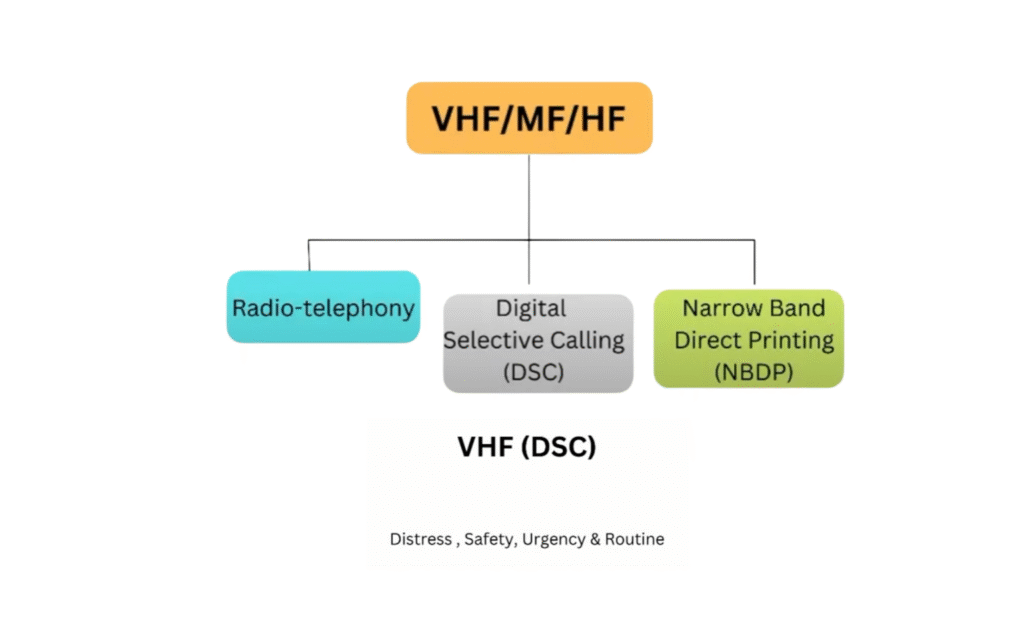
All GMDSS radios use three standard modes, each serving a specific purpose.
| Mode | Full Form | Main Purpose | Used On | Key Frequency |
|---|---|---|---|---|
| DSC | Digital Selective Calling | Automatic alerting (Distress / Safety / Routine) | VHF, MF, HF | VHF Ch 70 (156.525 MHz) |
| Radiotelephony | — | Voice communication | VHF, MF, HF | VHF Ch 16 (156.8 MHz) |
| NBDP | Narrow Band Direct Printing | Text-based communication | MF, HF | ITU-assigned channels |
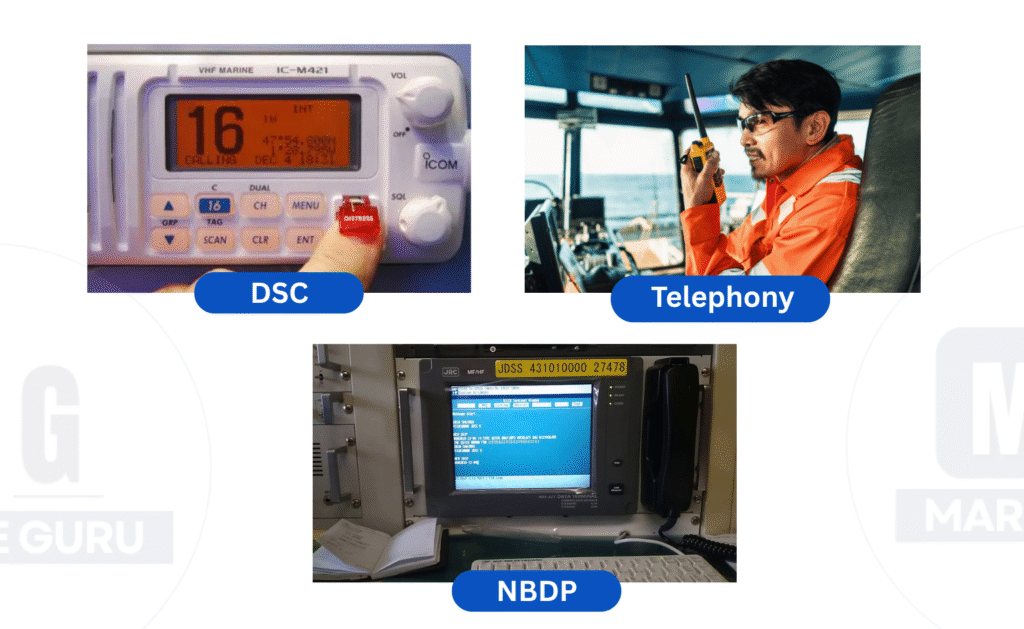
1. DSC (Digital Selective Calling) — The Automated Lifesaver
Function:
DSC transmits automatic encoded distress or routine alerts containing the ship’s MMSI number, GPS position, and type of distress — even if the operator cannot speak.
Used On:
- VHF DSC Controller (Short range up to 50 NM)
- MF/HF DSC Controller (Medium and long range)
Frequencies:
- VHF Channel 70 — 156.525 MHz
- MF — 2187.5 kHz
- HF — 8414.5 kHz (plus other ITU frequencies)
Example (Equipment + Mode):
Equipment: VHF DSC Controller
Mode: DSC
Situation: A cargo ship faces engine room fire.
The OOW presses the red DSC button. Instantly, nearby ships and coast stations receive your distress alert automatically, even before you can speak.
Memory Tip:
“70 for Digital SOS.” — Channel 70 is always for DSC distress alerting.
2. Radiotelephony — The Human Connection
Function:
Used for voice communication after DSC alerting.
Used On:
- VHF Radiotelephone (for short range)
- MF/HF Transceiver (for longer range)
Frequency:
- Channel 16 — 156.8 MHz (International distress and calling frequency)
Example (Equipment + Mode):
Equipment: VHF Radiotelephone
Mode: Radiotelephony
After sending a DSC alert, the OOW announces on Channel 16:
“Mayday, Mayday, Mayday, this is MV MarineGuru — fire in engine room, position 18°N 73°E.”
Nearby ships respond, acknowledging receipt.
Memory Tip:
“Sweet Sixteen Speaks.” — Channel 16 is always for voice distress.
3. NBDP (Narrow Band Direct Printing) — Maritime Messaging
Function:
Used for text-based communication (typed and printed).
Used On:
- MF/HF Telex or NBDP Terminal
- Common in long-range communications
Example (Equipment + Mode):
Equipment: MF/HF NBDP Transceiver
Mode: NBDP
The Chief Officer types and sends:
“Routine report: Cargo discharged. ETA Singapore 0900 LT.”
The shore office receives and prints it automatically.
Why It Matters:
- Works even when weather distorts voice signals.
- Creates a written legal record of communication.
Memory Tip:
“NBDP = Naval Printer.”
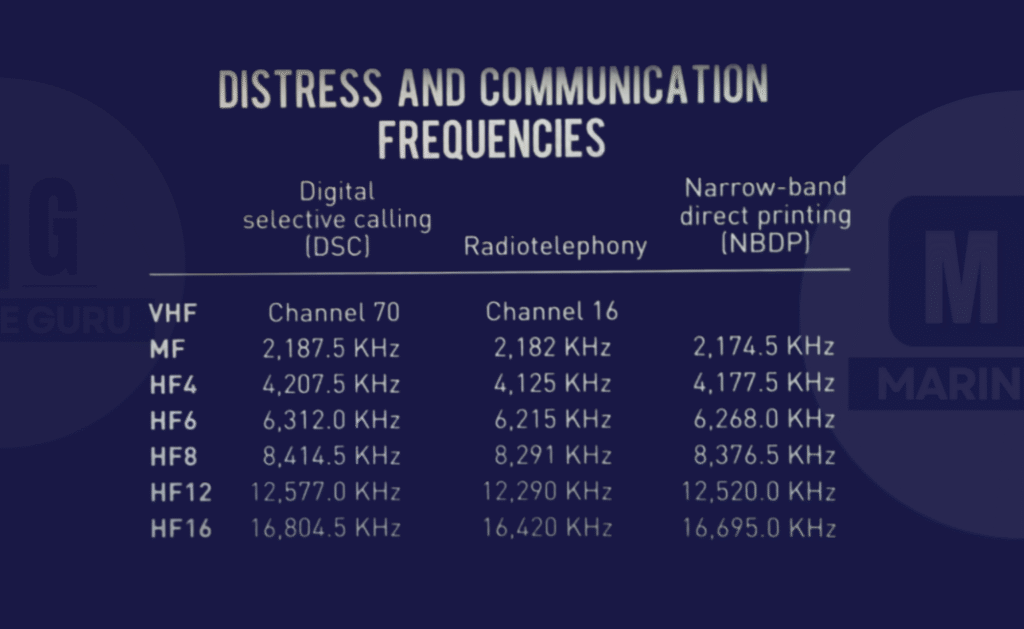
Radio Wave Propagation — The Journey of Your Signal
Whenever you transmit a message, your signal leaves the antenna and travels to its destination through one of four paths — known as propagation types.
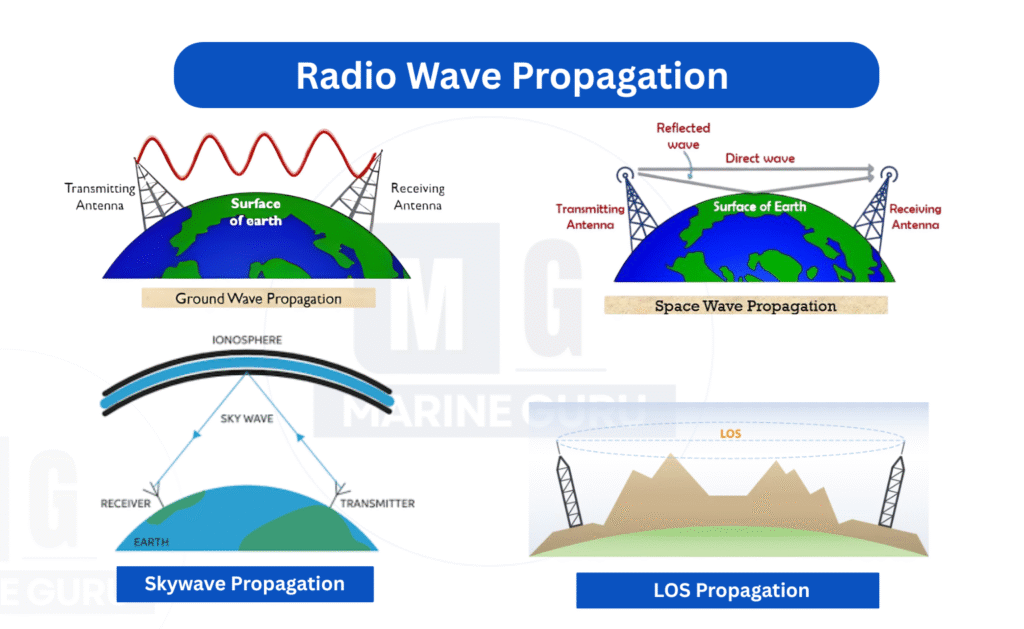
Each type affects which equipment and mode can be used effectively.
1️⃣ Ground Wave Propagation
Concept:
Radio waves travel along Earth’s surface, following its curvature.
Used By:
- MF Transceivers (NAVTEX, coastal Radiotelephony, or NBDP)
Range:
Up to 400 NM
Limitation:
Energy loss (attenuation) due to ground absorption.
Example (Equipment + Mode):
Equipment: MF Transceiver
Mode: Radiotelephony
Your ship contacts Mumbai Radio 300 NM away on 2182 kHz.
The signal weakens with distance — typical ground wave loss.
Memory Tip:
“Ground = Goes along the ground.”
“Longer the walk, weaker the talk.”
2️⃣ Space Wave Propagation
Concept:
Waves travel upward through the atmosphere at a critical angle, escaping into space and reaching satellites.
Used By:
- Satellite Communication Systems (Inmarsat-C, Fleet 77, EPIRB)
- Modes: Radiotelephony or Data
Example (Equipment + Mode):
Equipment: Inmarsat-C Terminal
Mode: Radiotelephony / Data
A distress alert is sent via Inmarsat-C.
The antenna tracks a geostationary satellite at a set elevation.
If misaligned, the signal misses — because it crossed the critical angle.
Memory Tip:
“Space waves shoot straight to satellites.”
“Critical angle = Gate to space.”
3️⃣ Skywave Propagation
Concept:
High-frequency (HF) signals bounce between Earth and the ionosphere, covering distances up to 2500 NM.
Used By:
- HF Transceivers in Radiotelephony, DSC, or NBDP modes
Example (Equipment + Mode):
Equipment: HF DSC Transceiver
Mode: NBDP
Your vessel in the Arabian Sea sends a report to Muscat RCC 2000 NM away.
The HF signal reflects from the F-layer and returns to Earth — successful skywave propagation.
Memory Tip:
“Sky = Skip = Reflection.”
Night-Time Propagation
At night, the ionospheric F1 and F2 layers merge, allowing signals to travel farther with less loss.
Example (Equipment + Mode):
Equipment: HF DSC Transceiver
Mode: DSC
At 0300 hrs, your HF distress alert reaches double the distance of daytime range.
Memory Tip:
“Night = Longer Flight.”
4️⃣ Line-of-Sight (Direct) Propagation
Concept:
The wave travels straight between antennas — blocked by solid obstacles.
Used By:
- VHF Radios, AIS, and Radar systems
- Modes: Radiotelephony / DSC
Example (Equipment + Mode):
Equipment: Portable VHF Radio
Mode: Radiotelephony
The bosun calls you from the forecastle on VHF, but you’re inside the engine control room.
No signal — steel bulkheads block line-of-sight.
You step onto deck, and his voice comes through clearly.
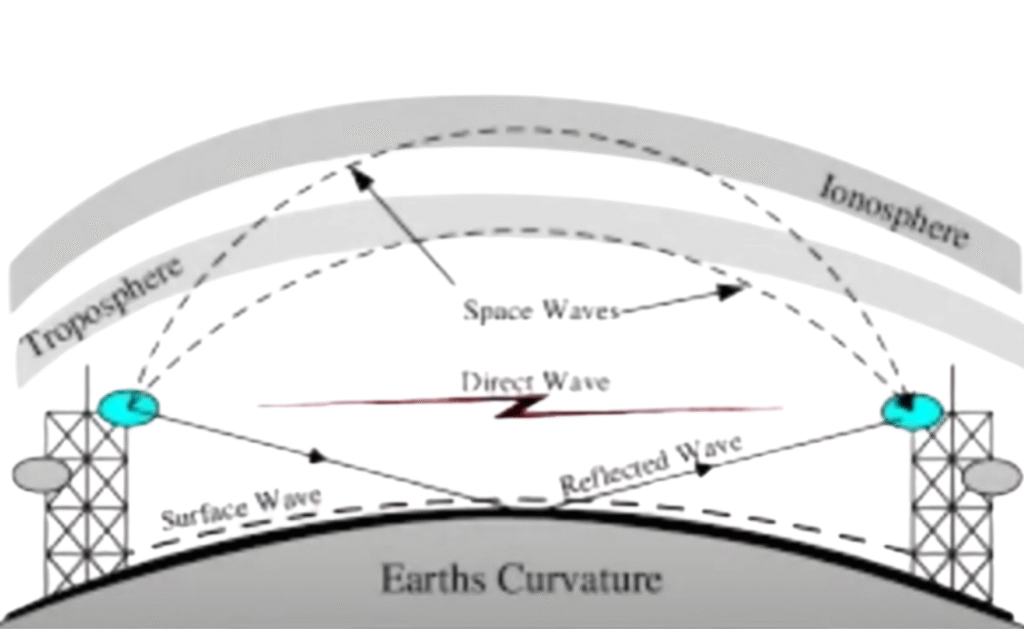
Memory Tip:
“If you can see them, you can hear them.”
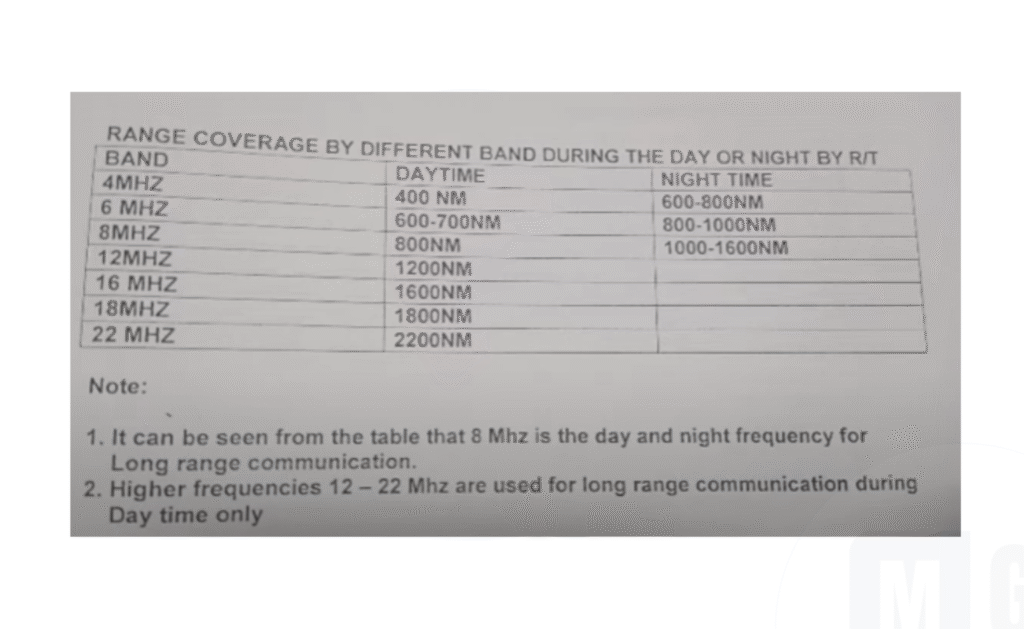
🧩 Summary Table
| Propagation Type | Equipment | Mode | Range | Explanation |
|---|---|---|---|---|
| Ground Wave | MF Radio | Radiotelephony/NBDP | 400 NM | Wave follows Earth’s surface |
| Space Wave | Inmarsat / EPIRB | Radiotelephony/Data | Global | Wave escapes atmosphere to satellite |
| Skywave | HF Radio | Radiotelephony/NBDP/DSC | 1200–2500 NM | HF reflects off ionosphere |
| Line-of-Sight | VHF / AIS / Radar | Radiotelephony/DSC | 20–50 NM | Travels straight, blocked by obstacles |
MarineGuru Memory Board
| Concept | Mnemonic | Meaning |
|---|---|---|
| Channel 70 | “70 for Digital SOS” | DSC Distress Channel |
| Channel 16 | “Sweet Sixteen Speaks” | Voice Distress Channel |
| NBDP | “Naval Printer” | Text Communication |
| Ground Wave | “Longer the walk, weaker the talk” | Signal loss over distance |
| Space Wave | “Critical angle = Gate to space” | Satellite Path |
| Skywave | “Night = Longer Flight” | HF improves at night |
| Line-of-Sight | “See = Hear” | VHF direct range |
FAQs — GMDSS Radio Equipment & Wave Propagation
Q1. What is GMDSS and why is it important?
The Global Maritime Distress and Safety System (GMDSS) ensures ships in distress can always communicate with shore authorities and nearby vessels through automated alerts, even if crew cannot manually call for help.
Q2. What are the main communication modes?
- DSC: Automated alerting (no voice)
- Radiotelephony: Voice conversation
- NBDP: Text-based printing messages
Q3. What is the difference between VHF, MF, and HF?
| Band | Range | Common Use |
|---|---|---|
| VHF | 20–50 NM | Bridge-to-bridge & distress (Ch 16, 70) |
| MF | 50–400 NM | Coastal communication |
| HF | 400–2500+ NM | Oceanic & intercontinental |
Q4. Why are Channel 16 and 70 important?
- Ch 70 (156.525 MHz) — DSC alerts
- Ch 16 (156.8 MHz) — Voice distress
Q5. Why does HF range increase at night?
The ionospheric F1 and F2 layers merge, reducing attenuation and increasing distance — known as night-time propagation.
Q6. What is attenuation?
Attenuation is the loss of signal strength as it travels — common in ground wave propagation.
Q7. What is the critical angle in space wave propagation?
The angle at which a radio wave must enter the ionosphere to escape into space without reflection — crucial for satellite links.
Q8. Why does VHF fail inside engine rooms?
Because VHF uses line-of-sight propagation, and steel structures block the signal.
Q9. How can I tell which propagation type is in use?
Check your equipment:
- VHF → Line-of-Sight
- MF → Ground Wave
- HF → Skywave
- Inmarsat → Space Wave
Q10. What documents show communication setup on board?
The Safety Radio Certificate (SRC) and Record of Equipment (Form R) list fitted GMDSS systems, coverage areas (A1–A4), and maintenance methods.
Q11. What are common GMDSS exam questions?
- Explain Skywave Propagation.
- What is attenuation?
- Why does HF work better at night?
- What is the critical angle?
- Define Line-of-Sight propagation.
Q12. How can I quickly memorize frequencies?
Use MarineGuru’s “3R” Trick:
Recognize → Relate → Repeat.
Example: “70 for Digital, 16 for Voice.”


